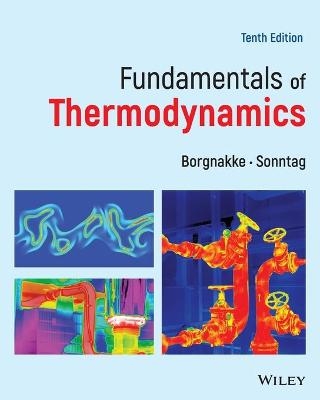
Fundamentals of Thermodynamics
John Wiley & Sons Inc (Verlag)
978-1-119-72365-3 (ISBN)
Covering classical thermodynamics with a focus on practical applications, this book provides a basic foundational skillset applicable across a variety of engineering fields. Worked examples demonstrate the appropriate use of new formulas, while clarifying the proper approach to generalized problems of a relevant nature. Going beyond the usual guidance in the basics of the field, this book is designed as comprehensive preparation for more advanced study in students' engineering field of choice.
1 Introduction and Preliminaries 1
1.1 A Thermodynamic System and the Control Volume 2
1.2 Macroscopic Versus Microscopic Points of View 5
1.3 Properties and State of a Substance 6
1.4 Processes and Cycles 6
1.5 Units for Mass, Length, Time, and Force 7
1.6 Specific Volume and Density 10
1.7 Pressure 13
1.8 Energy 20
1.9 Equality of Temperature 22
1.10 The Zeroth Law of Thermodynamics 22
1.11 Temperature Scales 23
1.12 Engineering Applications 24
2 Properties of a Pure Substance 29
2.1 The Pure Substance 30
2.2 The Phase Boundaries 30
2.3 The P–v–T Surface 34
2.4 Tables of Thermodynamic Properties 36
2.5 The Two-Phase States 39
2.6 The Liquid and Solid States 41
2.7 The Superheated Vapor States 43
2.8 The Ideal Gas States 46
2.9 The Compressibility Factor 49
2.10 Equations of State 54
2.11 Engineering Applications 55
3 Energy Equation and First Law of Thermodynamics 58
3.1 The Energy Equation 58
3.2 The First Law of Thermodynamics 61
3.3 The Definition of Work 62
3.4 Work Done at the Moving Boundary of a Simple Compressible System 67
3.5 Definition of Heat 75
3.6 Heat Transfer Modes 76
3.7 Internal Energy—A Thermodynamic Property 78
3.8 Problem Analysis and Solution Technique 80
3.9 The Thermodynamic Property Enthalpy 86
3.10 The Constant-Volume and Constant-Pressure Specific Heats 89
3.11 The Internal Energy, Enthalpy, and Specific Heat of Ideal Gases 90
3.12 Nonuniform Distribution of States and Mass 97
3.13 The Transient Process 98
3.14 General Systems that Involve Work 100
3.15 Engineering Applications 102
4 Energy Analysis for a Control Volume 111
4.1 Conservation of Mass and the Control Volume 111
4.2 The Energy Equation for a Control Volume 114
4.3 The Steady-State Process 116
4.4 Examples of Steady-State Processes 118
4.5 Multiple-Flow Devices 129
4.6 The Transient Flow Process 131
4.7 Engineering Applications 137
5 The Second Law of Thermodynamics 143
5.1 Heat Engines and Refrigerators 143
5.2 The Second Law of Thermodynamics 149
5.3 The Reversible Process 151
5.4 Factors that Render Processes Irreversible 153
5.5 The Carnot Cycle 156
5.6 Two Propositions Regarding the Efficiency of a Carnot Cycle 157
5.7 The Thermodynamic Temperature Scale 159
5.8 The Ideal Gas Temperature Scale 159
5.9 Ideal Versus Real Machines 161
5.10 The Inequality of Clausius 165
5.11 Engineering Applications 169
6 Entropy 173
6.1 Entropy—A Property of a System 173
6.2 The Entropy of a Pure Substance 175
6.3 Entropy Change in Reversible Processes 177
6.4 The Thermodynamic Property Relation 181
6.5 Entropy Change of a Solid or Liquid 182
6.6 Entropy Change of an Ideal Gas 183
6.7 The Reversible Polytropic Process for an Ideal Gas 187
6.8 Entropy Change of a Control Mass During an Irreversible Process 191
6.9 Entropy Generation and the Entropy Equation 192
6.10 Principle of the Increase of Entropy 194
6.11 Entropy as a Rate Equation 197
6.12 Some General Comments About Entropy and Chaos 202
7 Entropy Analysis for a Control Volume 206
7.1 The Entropy Equation for a Control Volume 206
7.2 The Steady-State Process and the Transient Process 207
7.3 The Steady-State Single-Flow Process 216
7.4 Principle of The Increase of Entropy 220
7.5 Engineering Applications; Energy Conservation and Device Efficiency 224
8 Exergy 231
8.1 Exergy, Reversible Work, and Irreversibility 231
8.2 Exergy and Its Balance Equation 243
8.3 The Second Law Efficiency 248
8.4 Engineering Applications 253
9 Power and Refrigeration Systems—With Phase Change 256
9.1 Introduction to Power Systems 257
9.2 The Rankine Cycle 258
9.3 Effect of Pressure and Temperature on the Rankine Cycle 261
9.4 The Reheat Cycle 265
9.5 The Regenerative Cycle and Feedwater Heaters 266
9.6 Deviation of Actual Cycles from Ideal Cycles 272
9.7 Combined Heat and Power: Other Configurations 276
9.8 Introduction to Refrigeration Systems 278
9.9 The Vapor-Compression Refrigeration Cycle 279
9.10 Working Fluids for Vapor-Compression Refrigeration Systems 282
9.11 Deviation of the Actual Vapor-Compression Refrigeration Cycle from the Ideal Cycle 283
9.12 Refrigeration Cycle Configurations 284
9.13 The Absorption Refrigeration Cycle 287
9.14 Exergy Analysis of Cycles 288
10 Power and Refrigeration Systems—Gaseous Working Fluids 293
10.1 Air-Standard Power Cycles 293
10.2 The Brayton Cycle 294
10.3 The Simple Gas-Turbine Cycle with a Regenerator 300
10.4 Gas-Turbine Power Cycle Configurations 302
10.5 The Air-Standard Cycle for Jet Propulsion 306
10.6 The Air-Standard Refrigeration Cycle 309
10.7 Reciprocating Engine Power Cycles 312
10.8 The Otto Cycle 314
10.9 The Diesel Cycle 317
10.10 The Stirling Cycle 320
10.11 The Atkinson and Miller Cycles 321
10.12 Combined-Cycle Power and Refrigeration Systems 324
Summary Objectives (Available in e-text for students) S-1
Study guide and Chapter Study Resources (Available in e-text for students) R-1
Chapters 11–15 (Available in e-text for students) W-1
Problems P-1
Contents of Appendix A-1
Appendix A SI Units: Single-State Properties A-3
Appendix B SI Units: Thermodynamic Tables A-23
Appendix C Ideal Gas Specific Heat A-73
Appendix D Equations of State A-75
Appendix E Figures A-80
Appendix F English Unit Tables A-85
Index I-1
| Erscheinungsdatum | 03.08.2020 |
|---|---|
| Verlagsort | New York |
| Sprache | englisch |
| Maße | 224 x 254 mm |
| Gewicht | 998 g |
| Themenwelt | Technik ► Maschinenbau |
| ISBN-10 | 1-119-72365-5 / 1119723655 |
| ISBN-13 | 978-1-119-72365-3 / 9781119723653 |
| Zustand | Neuware |
| Informationen gemäß Produktsicherheitsverordnung (GPSR) | |
| Haben Sie eine Frage zum Produkt? |
aus dem Bereich


